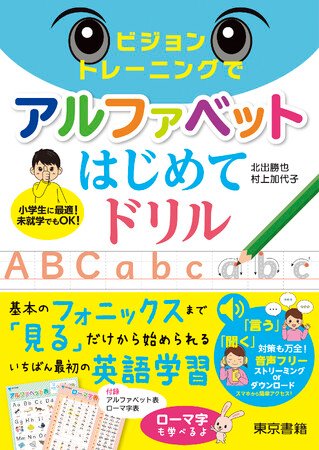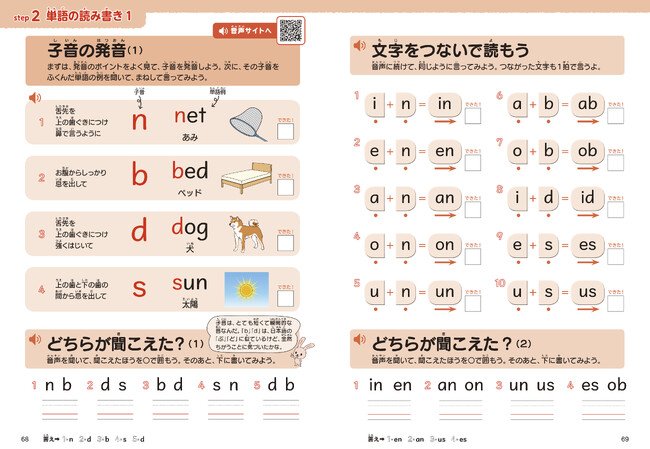Tokyo Shoseki Co., Ltd.
[2nd reprint completed! ] “First alphabet drill with vision training” A groundbreaking English learning that starts just by “looking”. Perfect for children who are learning English for the first time!
……
The English workbook “First Alphabet Drill with Vision Training”, which was released by Tokyo Shoseki Co., Ltd. in November 2020 and has been extremely popular, has now been reprinted (December 2023). [Image 8

Start with eye warm-up exercises
[Image 2

Explanation
The very first English workbook that any child can start without stumbling, combined with vision training, which is currently attracting attention in the educational world.
●Vision training is a training method that improves visual abilities such as the ability to control eye movements, and was originally developed for pilots in the United States Air Force. Today, it is a revolutionary learning method that is used not only in the military, but also in professional sports and in the treatment of dyslexia (reading and writing disorders). ●Some Japanese children find it difficult to write the alphabet. One reason for this is said to be that the eye movements used when writing hiragana and katakana are different from the eye movements used when writing the alphabet. This is because the writing style of the alphabet is different from Japanese letters, such as 1) the curve moves from right to left, and 2) the movement moves back along the same line. Because of this, children who are native Japanese speakers tend to have difficulty writing the alphabet. ●In this book, before learning to read and write letters, we will work on vision training supervised by experts to improve children’s visual functions, and then carefully teach them at home in small steps of reading and writing letters. I am able to teach you. ●You can also learn pronunciation rules = [phonics], and you can also learn [Romanization] while understanding the difference from English, making this a workbook that is the very first step in learning English. ●You can firmly acquire the basics of reading and writing in English using a method that does not make children feel that they are not good at it, and even children with developmental disabilities can work on it.
Train your eye movements while searching
[Image 3


You can also learn phonics
[Image 5

You can listen to the audio for free
[Image 6

You can also learn the Roman alphabet, which is learned in elementary school and is the basis of computer input.
[Image 7

Includes alphabet and Roman alphabet chart! !
Author information
Katsuya Kitade
Representative of visual function training center Joy Vision. American optometry doctor. Representative director of Visual Training Association, General Incorporated Association. Part-time lecturer at Kansai International University Faculty of Education. After graduating from Kwansei Gakuin University’s Faculty of Commerce, he studied at Kikuchi Optical College, and then studied abroad at Pacific University in the United States. Studied optometry and obtained the US national qualification “Doctor of Optometry.” After returning to Japan, as one of the few optometrists in Japan, he engaged in visual function testing and training guidance for children and athletes with vision problems. He is active in a wide range of activities, including writing books, giving lectures, and teaching study sessions. His major publications include “Vision Training to Make You Love Learning”, “Enjoy Vision Training in Class” (Tosho Bunkasha), “One Minute of Super Concentration Method by Just Moving Your Eyes” (Kobunsha), and “I’m Curious about Development.” Children’s Vision Training” (supervised by Natsume Publishing), etc.
Kayoko Murakami
Associate professor at Konan Women’s University. Representative of the Universal Design Research Association for English Language Education (AUDELL). Graduated from the University of Wisconsin-Madison, USA. Practical research on basic English reading and writing acquisition for children and students with developmental disabilities (mainly learning disabilities). Particularly involved in English phonological awareness, decoding (learning letter-sound correspondence) teaching methods, and teaching material development. He also holds lectures and training sessions on universal design lessons in English education and special needs education throughout the country. His main publications include “Aim! English Universal Design Lessons” (co-authored, Gakken), “English Vocabulary Teaching Work for Children Who Are Difficult to Read and Write” (Meiji Tosho Publishing), etc.
content
INDEX Before starting the table of contents drill 1 Look around exercise 2 Block strings 3 Line tracing 4 Trace and dot lace 5 Dot lace without tracing 6 Line color alphabet – step 1 Look – Finding uppercase letter companions (1) A to M uppercase letter companions Search (2) Looking for friends with N-Z uppercase letters (3) Looking for friends with uppercase letters A-M (4) Searching friends with lower-case letters N-Z (1) Looking for friends with a-m lowercase letters (2) Looking for friends with n-z lowercase letters (3) a ~m Find fellow lowercase letters (4) n – z Search for words (1) Search for words (2) Search for words (3) Search for words (4) Line connections (1) Line connections (2) Line connections (3) Line connections (4) ) Alphabet Chart Pair Maze Let’s make the shapes b, d, p, q – step 2 Listen – ABC touch (capital letters) Which one did you hear? (uppercase) abc touch (lowercase) Which one did you hear? (lowercase letters) Touch in the order you hear them (uppercase letters) Touch in the order you hear them (lowercase letters) -step 3 Say – Let’s say Zz from Aa Let’s sing the ABC song Can you imitate it well and say it? (1) Can you imitate it well and say it Kana (2) – step 4 Reading – Random reading of the alphabet (capital letters) Random reading of the alphabet (lower case) Let’s read the letters in a row (upper case) Let’s read the letters in a line (lower case) – step 5 Writing – Trace and write the capital letters Let’s try (for right-handed people) Let’s try to write uppercase letters (for right-handed people) Let’s try to write uppercase letters (for left-handed people) Let’s try to write uppercase letters (for left-handed people) Let’s try to trace and write lowercase letters Let’s try to write lowercase letters Lowercase letters Let’s trace and write (by group) Let’s write lowercase letters (by group) What’s hidden? (Capital letter 1) What is hidden? (capital letter 2) What is hidden? (lower case 1) What is hidden? (Lowercase 2) Let’s write the letters we hear (uppercase) Let’s write the letters we hear
(lowercase) Check to see if we can write them all Phonics and words – step 1 Phonics and vowels – What is phonics? Let’s memorize basic vowels – step 2 Reading and writing words 1 – Consonant pronunciation (1) Consonant pronunciation (2) Consonant pronunciation (3) – step 3 Word reading and writing 2 – Connect letters to read words (1) Letters Connect letters to read words (2) Connect letters to read words (3) Connect letters to read words (4) Connect letters to read words (5) Connect letters to read words (6) Words starting from vowels that connect consonants and consonants – step 4 Connect sounds and letters – Write the word that the picture represents (1) Choose the picture that the word represents (1) Connect the word and the picture (1) Proceed in the order you heard them (1) Connect the dots in the order you heard them (1) Write the words the pictures represent (2) Choose the pictures the words represent (2) Connect the words and pictures (2 ) Let’s go in the order we hear it (2) Connect the dots in the order we hear it (2) Let’s write the word that the picture represents (3) Let’s choose the picture that the word represents (3) Let’s connect the word and the picture (3) Hearing (3) Connect the dots in the order you heard them (3) Write the words that the pictures represent (4) Choose the pictures that the words represent (4) Connect the words and pictures (4) In the order you heard them Let’s move on (4) Connect the dots in the order you hear them (4) Write the words that the pictures represent (5) Choose the pictures that the words represent (5) Connect the words and pictures (5) Proceed in the order you hear them (5) Connect the dots in the order you heard them (5) – step 5 Connect sounds and words – read the words (1) Read the words (2) Which words did you hear? (1) Which word did you hear? (2) Let’s look for a word (upper case) Let’s look for a word (lower case) Check Check the words that come up Appendix: Roman alphabet Let’s look at the rules of Roman alphabet Let’s trace the Roman alphabet (1) Let’s trace the Roman alphabet ( 2) Let’s write a word Let’s write the sounds of snarling and stretching Let’s write our own name How to write the name of a prefecture Let’s write our address Let’s convert it to Roman characters on a computer Which key should I use?
https://www.tokyo-shoseki.co.jp/books/downloadpage/visional/ [Image 8

“First alphabet drill with vision training”
■Katsuya Kitade/Author Kayoko Murakami/Author
■List price 1,430 yen (1,300 yen tax 10%)
■B5・144 pages
https://www.tokyo-shoseki.co.jp/books/81353/
[Video 2:
